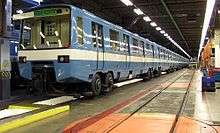MR-63
| MR-63 | |
|---|---|
 An MR-63 train housed at Beaugrand Garage, June 2004 | |
|
Refurbished interior of an MR-63 train at Honoré-Beaugrand station | |
| In service | October 14, 1966 – June 21, 2018 |
| Manufacturer | Canadian Vickers and CIMT-Lorraine |
| Built at | Viauville, Mercier–Hochelaga-Maisonneuve, Montreal |
| Constructed |
1963 (Motor) 1965–1967 (Trailer) |
| Entered service | October 1966 |
| Refurbishment | AMF Technotransport (1991–1993) |
| Scrapped | 2016–2018 |
| Number built | 369 vehicles (123 sets in 3-car formation, 41 sets in complete 9-car formation) |
| Number scrapped |
33 vehicles (destroyed in 1971 and 1974 fires) 313 vehicles (replaced like-for-like by MPM-10 between 2016 and September 15, 2018) |
| Formation | 6 and 9 cars per trainset |
| Fleet numbers |
81-501 to 81-746 (motor) 80-001 to 80-123 (trailer) |
| Capacity | 160 passengers per car, 39-40 passengers seated (1440 passengers in complete 9-car set) |
| Operator(s) | Société de transport de Montréal |
| Depot(s) | Angrignon, Beaugrand |
| Line(s) served | Green Line |
| Specifications | |
| Car body construction | Lightweight steel alloy |
| Width | 2.5 m (8 ft 2 3⁄8 in) |
| Doors | 4 pairs per side |
| Maximum speed | 70–72 km/h (43.5–44.7 mph) |
| Weight | 26,080 kg (57,500 lb) per car (unladen) |
| Traction motors |
360-V series rheostatic traction motors, Hitachi prototype chopper (elements 10, 11 and 12), Canron-Jeumont prototype chopper (elements 40, 41 and 42) |
| Power output | 113 kW (152 hp) |
| Acceleration | 4.8 km/(h⋅s) or 3.0 mph/s |
| Power supply | (?) |
| Train heating | Forced-air ventilation, in-train heater |
| Electric system(s) | 750-volt DC guide bars |
| Current collection method | Contact shoe side running |
| Bogies | 2 sets per car |
| Braking system(s) | Electromagnetic brakes using wooden brake shoes |
| Safety system(s) | ATC (ATO) |
| Track gauge |
1,435 mm (4 ft 8 1⁄2 in) standard gauge with a roll way on either side |
The MR-63 (Matériel roulant conçu en 1963) was the first and oldest generation of rubber-tired rolling stock of the Montreal Metro in the city of Montreal, Quebec, Canada. Based on the MP 59 of the Paris Métro in France, the trains were in use on three of Montreal's four Metro lines from 1966 until 2018.
Design and improvements
In 1963, the Commission de transport de Montréal (CTM) awarded the MR-63 contract to Canadian Vickers over Montreal Locomotive Works (MLW), as Canadian Vickers had the support of the French company CIMT-Lorraine which helped to design the rubber-tired system used on some of the Paris Métro lines. Between 1965 and 1967, 369 MR-63 coaches were built at the Canadian Vickers shipyards in the Viauville neighbourhood of the Mercier–Hochelaga-Maisonneuve borough of Montreal, based on a design by Jacques Guillon, and the first trains were introduced on October 14, 1966 on the opening of the Montreal Metro. During their time in service the fleet has undergone numerous technological and reliability upgrades, starting with the introduction of Automatic train operation in 1976 (with subsequent revisions of hardware and software), major refurbishments of all 336 in-service MR-63 coaches by AMF Technotransport at the CN Pointe-Saint-Charles workshops between 1991 and 1993, solid-state door interlocks in 2003, modern ergonomic driver cabs with new digital dashboards, and automatic station announcements in 2005 (voiced by Michèle Deslauriers).
The MR-63 was identified with grey interiors, four ventilation hoods protruding over the roof of each car, two 113 kW (152 hp) 360-V series traction motors that make a whining noise, and round cab headlights. By the time of their withdrawal, Montreal's rolling stock was among the oldest still in use on any metro system in the world,[1] though for comparison the New York City Subway's R32s are even older and remain in revenue service.
Hitachi and Jeumont prototype trains
In the early 1970s, two separate three-car trainsets had their original traction systems replaced with two chopper prototype traction systems, one manufactured by Hitachi (fitted onto elements 10, 11 and 12), and another manufactured by the Canron company based on a Jeumont original design (fitted onto elements 40, 41 and 42). The Hitachi chopper system fitted onto elements 10, 11 and 12 were subsequently changed back into their original traction systems a few years later. Jeumont elements 41 and 42 were however stored out of service until 2005 when they returned as trailer cars attached to other motor cars, where they remained in service until 2017, when they were retired alongside other MR-63s being replaced by MPM-10 trains. Jeumont element 40 was retired from service earlier than elements 41 and 42 because it needed to be cannibalised for spare parts for elements 41 and 42 that were no longer being manufactured. Jeumont element 40 has since then been used as part of the Just for Laughs festival.[2] The Canron-Jeumont chopper 3-car trainset produce an unusually loud 5-tone chorus as the train begins its initial acceleration out of the station. The frequencies used (90 Hz, 120 Hz, 180 Hz, 240 Hz, and 360 Hz) just so happen to produce a musically appealing sound that was later incorporated, by popular demand,[3] into the 3-tone door closing chimes of the later MR-73 trains since 2012.
Reliability
Maintenance of Montreal's subway cars is rigorous, as reliability levels (Mean Distance Between Failures/MDBF ratings) are more than double that of typical North American subway cars by North American standards (at 200,000 km or 124,300 mi in 2004). However, they suffer elevated levels of vandalism, they retain many obsolete components, parts availability is diminishing, and ride quality has deteriorated over the years as their suspension systems and rubber spring packs harden with age. Poor ride quality has not been attributed to the tires or tracks.
Motor design
The MR-63 model uses a series-to-parallel servo camshaft rheostat to control and regulate power to its traction motors; this control system can be heard tapping under the floor of a motor car as the train undergoes rapid acceleration at an initial rate of 1.33 m/s2 (4.4 ft/s2) (4.8 km/(h⋅s) or 3.0 mph/s). This control system also features a dynamic rheostatic braking mode that uses the motors to slow the train, turning the motors into generators and dissipating the resulting energy as heat in the rheostat grid.
Lines serviced
![]()
![]()
![]()
![]()
Previous Formation
| Line # | Colour | Number of trains | Composition | Comments |
|---|---|---|---|---|
| 1 | 33 (288 cars) | (81-xxx + 80-xxx + 81-xxx + 81-xxx + 80-xxx + 81-xxx + 81-xxx + 80-xxx + 81-xxx) | In this line replaced with by MR-73 and MPM-10 Azur cars. | |
| 2 | 4 (33 cars) | (81-xxx + 80-xxx + 81-xxx + 81-xxx + 80-xxx + 81-xxx + 81-xxx + 80-xxx + 81-xxx) | Destroyed in 1971 to 1974 in collision from Henri Bourassa | |
| 4 | 5 (36 cars) | (81-xxx + 80-xxx + 81-xxx + 81-xxx + 80-xxx + 81-xxx + 81-xxx + 80-xxx + 81-xxx) | ||
| 5 | 1 (6 cars) | (81-xxx + 80-xxx + 81-xxx + 81-xxx + 80-xxx + 81-xxx) | Last Service on June 21, 2018 | |
Fleet Number
(Example: 81-1xxx + 80-0xxx + 81-1xxx) (originally) 1966-1977
(Example: 81-xxx + 80-xxx + 81-xxx) (current) 1977-2018
Rolling Stock State
In 1971, Damaged collision at Henri-Bourassa, There 12 sets are:
| Fleet numbers[4] | ||
|---|---|---|
| Original | Current | Notes |
| (81-1509 + 80-0005 + 81-1510) | 81-509 + 80-005 + 81-510 | * |
| (81-1527 + 80-0014 + 81-1528) | 81-527 + 80-014 + 81-528 | ** |
| (81-1539 + 80-0020 + 81-1540)*** | 81-539 + 80-020 + 81-540*** | * |
| (81-1575 + 80-0038 + 81-1576) | 81-575 + 80-038 + 81-576 | * |
| (81-1587 + 80-0044 + 81-1588) | 81-587 + 80-044 + 81-588 | ** |
| (81-1593 + 80-0047 + 81-1594) | 81-593 + 80-047 + 81-594 | * |
| (81-1633 + 80-0067 + 81-1634) | 81-633 + 80-067 + 81-634 | * |
| (81-1655 + 80-0078 + 81-1656) | 81-655 + 80-078 + 81-656 | ** |
| (81-1667 + 80-0084 + 81-1668) | 81-667 + 80-084 + 81-668 | * |
| (81-1677 + 80-0089 + 81-1678) | 81-677 + 80-089 + 81-678 | ** |
| (81-1679 + 80-0090 + 81-1680)*** | 81-679 + 80-090 + 81-680*** | * |
| (81-1683 + 80-0092 + 81-1684) | 81-683 + 80-092 + 81-684 | * |
| Legends | ||
| ||
Accidents and incidents
- In July 1967, a train operator fainted at the controls of a MR-63 train and hit the wall at the tail-end of the Yellow Line, due to the intense heat generated from the train heaters compounded by the insufficient air flow generated by the forced-air ventilation mounted on top of the train. As a result of said incident, air conditioning was subsequently installed in all MR-63 driver cabs and the forced-air ventilation inside the passenger cabins were modified to generate greater air flow.
- On December 8, 1971, a speeding MR-63 train crashed into a parked MR-63 train near Henri-Bourassa station on the Orange Line, causing a 17-hour inferno that destroyed 24 MR-63 coaches parked at the Henri-Bourassa tail tracks. 40-year-old train operator Gerard Maccarone was the sole fatality in this accident, which was later revealed to be caused by a jammed throttle that prevented the train from braking in time. This was at that time the deadliest subway accident ever to have occurred in Canada until the Russell Hill subway accident on the Toronto subway in 1995.[5]
- On January 9, 1974, a series of tire blowouts on a 9-car MR-63 train led to a fire which occurred between Laurier and Rosemont stations on the Orange Line. No deaths resulted from said fire, although said train was completely destroyed.
Retirement

The MR-63 trains were retired beginning in 2016 with the introduction of the MPM-10 trains. The last MR-63 trains were retired between the last few months of 2017 and June 2018.[6]
On May 30, 2018, the Société de transport de Montréal (STM) announced that after June 21, 2018 with 52 years of loyal service, all of its remaining MR-63 métro cars were being withdrawn from service. The milestone was underlined by a communication campaign and a "farewell tour" on all four Montreal Metro lines. The last original train was decorated with information about the cars and featured copies of posters from 1966 from its early operation. It was operated as part of normal morning and afternoon rush hour service on each line according to the following schedule:
![]()
![]()
![]()
![]()
Car 81-502, the first MR-63 car delivered, was preserved and will be on display at Exporail, the Canadian Railway Museum, in Saint-Constant, Quebec, beginning in Fall 2018.[7] The rest of the fleet are now going under a sustainable reclamation plan.[8][9]
See also
References
- ↑ "Goodbye, retro Métro". Maclean's. January 31, 2011. Retrieved June 23, 2017.
- ↑ http://www.logiquefloue.ca/metro/train-jeumont/station-chantilly/. Retrieved 2013-02-14.
- ↑ "Dou dou dou...the Montréal métro's signature sound". STM. September 18, 2010. Retrieved June 23, 2017.
- ↑ Exporail Trains
- ↑ http://www.cbc.ca/archives/entry/fire-hits-the-montreal-metro
- ↑ read:http://montrealgazette.com/news/local-news/farewell-tour-for-the-mr-63-the-montreal-metros-52-year-old-workhorse
- ↑ http://www.stm.info/en/about/discover_the_stm_its_history/history/thanks-mr-63#titre-h2-Retiring_to_the_museum--5
- ↑ http://www.stm.info/en/about/major_projects/sustainable-reclamation-plan-mr-63-cars
- ↑ http://projetmr-63.com/en/
External links
